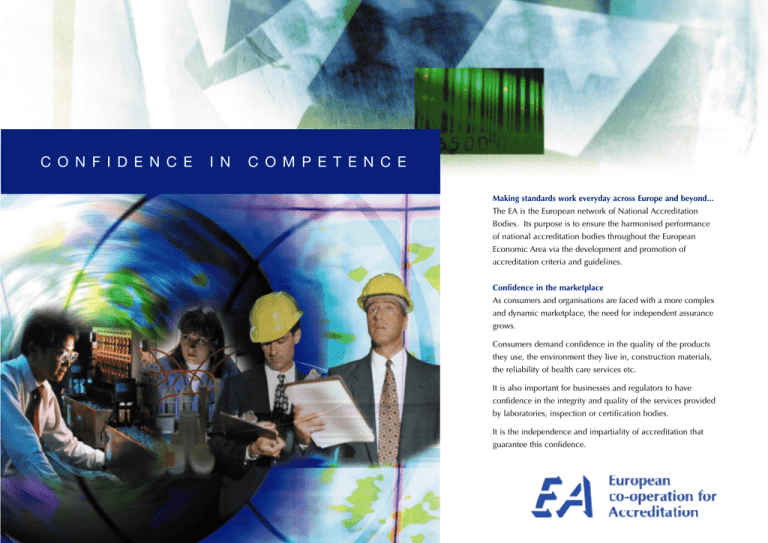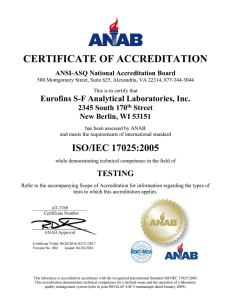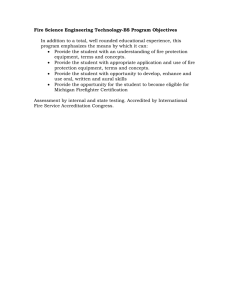Confidence in competence
advertisement

C O N F I D E N C E I N C O M P E T E N C E Making standards work everyday across Europe and beyond... The EA is the European network of National Accreditation Bodies. Its purpose is to ensure the harmonised performance of national accreditation bodies throughout the European Economic Area via the development and promotion of accreditation criteria and guidelines. Confidence in the marketplace As consumers and organisations are faced with a more complex and dynamic marketplace, the need for independent assurance grows. Consumers demand confidence in the quality of the products they use, the environment they live in, construction materials, the reliability of health care services etc. It is also important for businesses and regulators to have confidence in the integrity and quality of the services provided by laboratories, inspection or certification bodies. It is the independence and impartiality of accreditation that guarantee this confidence. What is accreditation? Ensuring Confidence in the Marketplace Accreditation determines the technical competence of a body to perform specific tasks. Accreditation has to be a non-competitive activity because of its role in ensuring that standards are not compromised by competition between bodies providing services and products. The Benefits of Accreditation For Government: For accredited organisations: – Accreditation is the preferred mechanism for ensuring public confidence in the reliability of activities that impact on health, welfare, security and the environment. Accreditation is used, therefore, to identify Competent Bodies for the implementation of government policies and regulations. – Accreditation is objective proof that organisations comply with best practices. It is the internationally recognised system that is used to develop and sustain high standards of performance. It is a winning formula for eligibility to tender for international projects. What is EA? The EA, a network of accreditation bodies in Europe The EA is a non-profit membership-based organisation of nationally recognised accreditation bodies located in the European geographical area. For consumers: For industry: – Accreditation is an essential tool for decision-making and risk management. Organisations can save time and money by selecting an accredited and therefore competent supplier. – Accreditation can provide a competitive advantage and facilitates access to export markets within Europe and beyond – with the aim of “tested or certified once, accepted everywhere.” – Accurate measurements and tests carried out in compliance with best practices limit product failure, control manufacturing costs and foster innovation. – Accreditation gives consumers confidence through ensuring consistently high standards in the quality of products or services purchased. The EA, which operates as a competition free network, has the following objectives: ■ To contribute towards the elimination of technical barriers to trade by achieving a uniform approach to accreditation and conformity assessment services ■ To act as a technical support to the European Commission and the EFTA facilitating the implementation of Directives and the development of mutual recognition agreements ■ To promote the international recognition of accreditation and accredited services by maintaining sound and reliable multilateral agreements. The EA operates in close co-operation with its stakeholders The stakeholders of the EA include: – conformity assessment bodies (laboratories, certification and inspection bodies), the European Commission and EFTA, regulators, industry and consumers. Their interests are represented through membership of the EA Advisory Board (EAAB) and EA committees. The difference between accreditation and certification for laboratories and inspection bodies Unlike ISO 9001 certification, accreditation uses criteria and procedures specifically developed to determine technical competence. Whereas ISO 9001 certification demonstrates conformity to the standard requirements, accreditation demonstrates specific technical competence. C O N F I D E N C E I N C O M P E T E N C E What is the EA Multilateral Agreement? Worldwide Recognition and International Acceptance The EA multilateral agreement (MLA) provides a means for goods and services to cross boundaries in Europe and throughout the world. The MLA makes accreditation a “passport” which facilitates access to the EU and international markets through co-operation with ILAC (International Laboratory Accreditation Co-operation) and IAF (International Accreditation Forum). The Accreditation Body’s mark on test reports and certificates is your assurance of the benefits of the MLA. How does the Agreement work? The establishment of the MLA between the EA accreditation body members creates mutual confidence in, and acceptance of, accredited certifications, inspections, calibration certificates and test reports. The MLA eliminates the need for suppliers of products or services to be certified in each country where they sell their products or services. Individual EA members that are signatories to the EA MLA are subject to regular and stringent multi-national peer evaluations. The purpose of these routine on-site evaluations is to verify the signatories’ continuing conformity with the internationally accepted criteria. These peer evaluations ensure consistent, harmonised accreditation practices and also facilitate the exchange of information and experiences between the signatories. The Scopes of the EA Multilateral Agreement ■ Laboratory Accreditation ■ Testing, calibration ISO/IEC 17025, ISO 15189 ■ Eco-Management and Audit Scheme (EMAS) Council Regulation 761/2001 of 19th March 2001 Certification Body Accreditation Product Certification EN 45011 (ISO/IEC Guide 65) Personnel Certification EN 45013 (ISO/IEC 17024) Quality Management System Certification EN 45012 (ISO/IEC Guide 62) Environmental Management System Certification ISO/IEC Guide 66 Accreditation of EMAS Verifiers ■ Accreditation of Inspection Bodies EN 45004 (ISO/IEC 17020) www.european-accreditation.org H AV E C O N F I D E N C E ■ Look for the national accreditation body’s mark. ■ Check the mark on the web site and find out more about EA and the accredited bodies in EA at www.european-accreditation.org. ■ Download the list of the EA multilateral agreement signatories (document EA 1/08). I N C O M P E T E N C E


